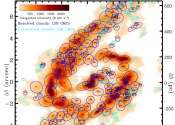Astronomers investigate giant molecular clouds in the galaxy NGC 613
Using the Atacama Large Millimeter/sub-millimeter Array (ALMA), an international team of astronomers has performed high-resolution observations of a nearby galaxy known as NGC 613. Results of the observational campaign, published ...




